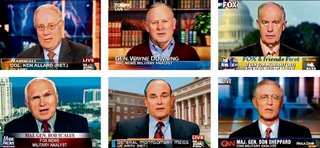<embed> Influencer </embed>
<type = “military man”>
<look = “uniformed”>
<display = “next to anchorman”>
<play = “when Iraq goes poorly”>

<repeat = “as necessary”>
According to a feature-length story in the New York Times this sunday it seems that the military has been using Influencers to get its message out. These are the guys that you see on TV news and talk shows extemporizing on their personal and professional experience to lend unique perspectives and insights to what’s happening “on the ground” in Iraq. Some of them speak to military strategy and tactics, appearing on TV, and sometimes in uniform, to guide news anchors and civilian discussants.
Apparently these guys have been courted by the Pentagon for years, and during the Rumsfeld years even provided him with talking points. How to reach the audience and simplify the story for them (us).
The military’s been doing Influence marketing-style, but in mass media. (There was no mention of these guys having blogs, and I haven’t the time to check.) A couple questions spring to mind: Are we surprised? (probably not.) Could this happen in social media? (probably not.)
Mass media according to the rules of corporate media, which is to say that they are owned by large profit-making concerns. While they are as keen on making the news interesting as the blogosphere, their tendency will be to weave new information into a tight and closed narrative form. They tell stories. We in the blogosphere opinionate, bug, goad, poke and disclose. However, the mass media still believe that their best narrative structure is the story. And when the story itself lacks a clear beginning, middle, and (in this case particular) ending, use of experts and authorities shifts the burden from narrative to narrator.
In this they have the gist of Influence nailed, absolutely. But in that Influence is embedded within official and even ideological, partisan, or agency dogma, its utility as promotional speech is exhausted on behalf of official and biased needs and interests. The influence of (ex) military consultants borrows from the professional role and position. It is not the same kind of influence that social media marketers, for example, use when embedded in messages among cultural influencers. These military experts must be brought into the mass media if they are to have and exercise influence. It’s not influence borrowed (as in social media) but influence regenerated. Influence not from self-presentation but from re-presentation.
The common challenge facing those of us in mass media is commerce and maintaining the line between commercial and everyday speech that separates advertising and sales, which are discourses lacking authenticity, and ordinary talk, which do lay claim to authority and credibility. The type of influence used in the case noted by the New York Times, however, is one of “officialdom” and the power of position and normative authority.
If in mass media, influence of position and authority can be better maintained than in social media because mass media are top-down talking head news and reporting, sustained by the credibility invested in the medium and business of journalism and broadcast news. The medium, as well as its mode of distribution, more easily maintain the cycle and engine of legitimation that culminates in the appearance of professional experts on broadcast talk shows and the evening news. This is legitimation by control, by production, and by fabrication. It’s expertise subject to the editing room.
Social media seek (in theory and in word, at least) a different kind of influence: peer review and approval. The medium and the form of discourse that it supports are wide open. In fact they can approach forms of conversational talk, even. This is no medium for the accreditation and credibility of the role and position — it’s a medium in which credibility is obtained from the risk and exposure of participation and interaction.
All influencers are equal, but some are more equal than others.
